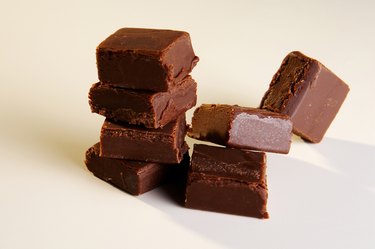
Getting your oven temperature right is important in baking, but usually you can compensate for a hotter or cooler oven by adjusting the baking time. Candymaking doesn't give you the same kind of latitude, because the texture of your finished treats depends almost entirely on accurate temperature management. If your fudge turns out chewy instead of soft and creamy, it usually means you've gotten the temperature wrong.
Mind Your Concentration
Video of the Day
Like most forms of candymaking, fudge is all about heating sugar to dissolve its crystalline structure and then controlling how it recrystallizes. The sugar must first be dissolved in a liquid, then cooked until much of that liquid is driven off to produce a highly saturated sugar solution. Laboratory instruments can measure the concentration of sugar, but temperature tells the story just as well. As the water level in a syrup drops, its boiling temperature rises. If you have an accurate candy thermometer, the temperature tells you when you've reached the correct degree of concentration. For fudge, that's the so-called soft-ball stage, which extends from 234 to 240 degrees Fahrenheit.
Video of the Day
Chewy and Gooey
The ideal temperature for fudge is right at the bottom of that range, at 232 to 234 F. If you boil the fudge to a temperature lower than 232 F, your fudge will retain extra moisture, which can make it chewy or in extreme cases, prevent it from setting at all. If the temperature goes much beyond 234 F, the fudge's final texture will be hard, dry and crumbly. Catching your sugar mixture at the right moment requires either enough experience to recognize the correct consistency or using an accurate candy thermometer.
Testing Two Ways
Candy thermometers are often inaccurate, a definite problem when a few degrees either way mean the difference between success or failure. Before you rely on your candy thermometer for fudge, test it in a pot of boiling water. At sea level, it should read 212 F and if it's higher or lower than that, make note of the discrepancy. For example, if it shows 217 F, you know it measures 5 degrees high and you'll cook your fudge until that thermometer shows 239 F. Alternatively, keep a measuring cup of cold water beside your stove. As the fudge nears its recommended cooking time, dribble some of the syrup into the cup. If it forms a soft ball that flattens easily between your fingers, it's ready.
Give it a Beating
After cooking your fudge to the correct temperature, you're still not home free. The next step is to cool the sugar syrup until it's barely warm, about 110 F, and then beat it. If you start while the fudge is too warm, it will become grainy. If you don't beat it enough, it will remain soft and slightly chewy. It takes a long time to produce the correct temperature, often up to 20 minutes of beating, which will tax the sturdiest of arms. Use a stand mixer or high-powered hand mixer if you have one, or have a few helpers ready to take over when you're tired. Beat the fudge until it loses its glossy sheen, then pour it into a buttered pan to finally set.